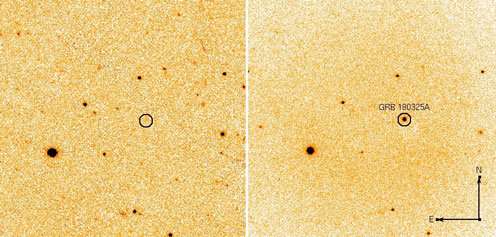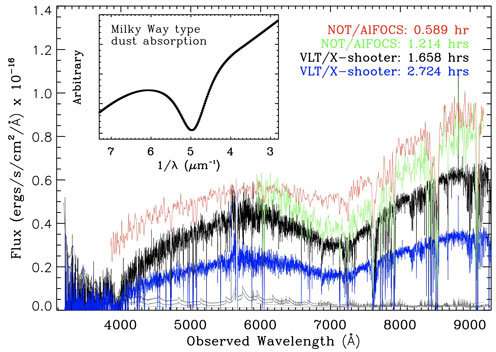Milky Way-type dust particles discovered in a galaxy 11 billion light years from Earth

An international research team, with participation from the Niels Bohr Institute at the University of Copenhagen, has found the same type of interstellar dust that we know from the Milky Way in a distant galaxy 11 billion light years from Earth. This type of dust has been found to be rare in other galaxies and the new discovery plays an important role in understanding what it takes for this particular type of interstellar dust to be formed.
Galaxies are complex structures comprised of many individual parts, such as stars, gas, dust and dark matter. Even though the dust only represents a small part of the total amount of matter in a galaxy, it plays a major role in how stars are formed and how the light from the stars escapes the galaxies. Dust grains can both absorb and scatter light. Dust particles also play a decisive role in the formation of planets and thus also for the understanding of our own existence on Earth.
The dust in galaxies consists of small grains of carbon, silicon, iron, aluminium and other heavier elements. The Milky Way has a very high content of carbonaceous dust, which has been shown to be very rare in other galaxies. But now a similar type of dust has been found in a few, very distant galaxies that researchers have been able to investigate using light from gamma-ray bursts. Gamma-ray bursts come from massive stars that explode when the when the fuel in its core is exhausted. The explosion causes the dying stars to emit powerful bursts of light that astronomers can use to analyse what the galaxies are comprised of. Specifically, they can measure the elemental content and analyse their way forward to the properties of the dust properties by examining the light that escapes from the galaxies.
The carbonaceous dust is registered in the measurements as a "dust bump", that is, a high value of dust with the said composition. This ultraviolet dust bump has now been detected in a gamma-ray burst, which has been named GRB180325A and the result has just been accepted for publication in the journal Astrophysical Journal Letters. The lead author is Tayyaba Zafar who completed her Ph.D. studies at the Niels Bohr Institute in Copenhagen and is now working at the Angle Australian Observatory in Australia. Several other researchers from NBI are co-authors of the article.
GRB180325A was detected by Neil Gehrel's Swift Observatory (NASA) on 28 March 2018. Swift is a satellite mission that detects gamma rays from the dying stars. When such a detection from the satellite hits the astronomers, a hectic period begins. The astronomers try to observe that part of the sky as quickly as possible in order to secure the crucial information that allows them to study the interior of the galaxy the explosion originated from. In this case Kasper Heintz, who did his master's thesis at the Niels Bohr Institute and is now a Ph.D. student at the University of Iceland, was on duty. He activated the Nordic Optical Telescope (NOT) at La Palma, where Professor Johan Fynbo from the Niels Bohr Institute was observing for another project. The first observations of the light from the gamma-ray burst were secured only a few minutes after the discovery by Swift.

The observations from NOT showed that the star had exploded in a galaxy with a red shift of 2.25, which means that the light has travelled approximately 11 billion light years. The observations immediately showed that the dust bump, known from the Milky Way, was present in this galaxy. The team then observed the gamma-ray burst with the X-shooter spectrograph on ESO's Very Large Telescope (European Southern Observatory) on the Cerro Paranal in Chile. All in all, four spectra of the afterglow from the gamma-ray burst were secured – all with a clear detection of the dust bump.
"It is a beautiful example of how observations in space and around the world can work together and create breakthroughs in research. The work also gives cause to express great thanks to the Carlsberg Foundation, without which Danish astronomy would neither have access to the Very Large Telescope nor NOT," says Professor Johan Fynbo.
"Our spectra show that the presence of atomic carbon seems to be a requirement for the dust that causes the dust bump to be formed," says Kasper Heintz.
The dust bump has previously been seen in observations of four other gamma-ray bursts, the last of which was detected 10 years ago.
"Further observations of this type will allow us to find more galaxies with this dust bump and thus conduct a more systematic study of similarities and differences in dust composition throughout the history of the Universe and in galaxies with different properties," says Dr. Tayyaba Zafar.
More information: T. Zafar et al. The 2175 Å Extinction Feature in the Optical Afterglow Spectrum of GRB 180325A at z = 2.25, The Astrophysical Journal (2018). DOI: 10.3847/2041-8213/aaca3f , arxiv.org/abs/1806.00293
Journal information: Astrophysical Journal , Astrophysical Journal Letters
Provided by Niels Bohr Institute





















